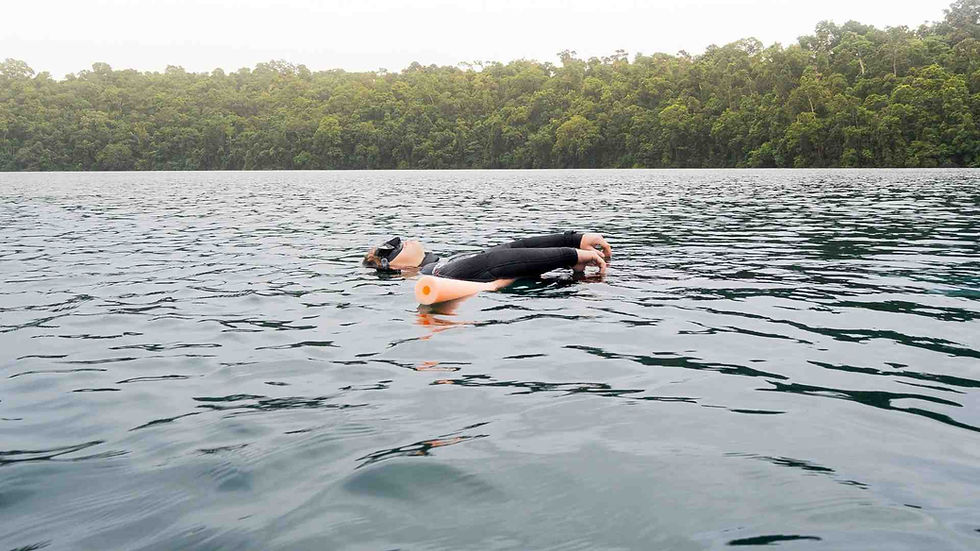How to Breathe-Up for Freediving: A Guide For Better Breathholds
- Curtis Tredway
- Oct 24, 2024
- 3 min read
Updated: Nov 20, 2024

The breathe-up is one of the most important steps in freediving, setting the stage for a longer, safer, and more comfortable breath-hold. It’s a pre-dive breathing technique that prepares your body by reducing your heart rate, calming your mind, and maximising oxygen efficiency.
Here’s a short guide on how to breathe-up for freediving effectively.
What is the Breathe-Up?
In freediving, the breathe-up is the relaxation phase leading up to a breath-hold. The main goal is to normalise breathing, lower the heart rate, and prepare the body to hold its breath for an extended period. A proper breathe-up helps trigger the Mammalian Dive Reflex, a natural adaptation that conserves oxygen by slowing the heart rate and redirecting blood flow to vital organs.
Despite what many people believe, the breathe-up isn't some magical forumla that will increase your oxygen intake and extend your breathhold. If there is any Instructor out their promising some secret method to increasing your breathhold, they're lying.
The breathe-up, also known as the relaxation phase, is about preparing the body for a breath-hold by engaging the parasympathetic nervous system—often referred to as the "rest and digest" system. The goal isn’t to take in significantly more oxygen, as this isn’t feasible without breathing pure oxygen. Instead, the breathe-up focuses on reducing the heart rate, calming the mind, and minimising energy expenditure. By promoting relaxation and optimising these physiological responses, freedivers can conserve oxygen more effectively and feel more at ease before a dive.
Step-by-Step Breathe-Up Technique
Find a Comfortable Position: Start by lying on your back, sitting upright, or floating face-up in the water, whichever feels most comfortable. Focus on staying relaxed, with minimal movement to conserve energy.
Begin Belly Breathing: Breathe slowly and deeply into your belly rather than your chest. Place a hand on your stomach and feel it expand with each inhale. This helps activate the parasympathetic nervous system, promoting relaxation.
Maintain Tidal Breathing: Use a natural, steady breathing rhythm, similar to how you breathe at rest. Avoid deep, forceful breaths or hyperventilation. Tidal breathing typically follows a gentle 1:2 ratio, where the exhale is about twice as long as the inhale. For example, if you inhale for 2 seconds, aim for a 4-second exhale.
Extend the Exhale SlightlyFocus on a slightly longer exhale to further slow down your heart rate. Allow the air to flow out naturally without pushing or straining. This helps activate relaxation even more effectively.
Repeat for 2-3 MinutesContinue this relaxed breathing pattern for at least 2-3 minutes, or until you feel calm and centred. Use this time to clear your mind and focus on releasing any tension in your body.
Take Your Final BreathWhen you’re ready to begin your breath-hold, take a final, deep breath into your belly, then your chest, and finally fill the mouth and throat without overinflating. Hold your breath and relax into the dive.
The Importance of Relaxation During the Breathe-Up
The key to an effective breathe-up is relaxation. The more relaxed you are, the slower your heart rate will be, which conserves oxygen for your breath-hold. The breathe-up is not about taking in as much air as possible but about calming the body and mind to make your breath-hold more comfortable and efficient.
What to Avoid During the Breathe-Up
Hyperventilation: Breathing too rapidly or deeply reduces CO2 levels too much, which can delay the urge to breathe and increase the risk of shallow water blackout.
Overthinking: Try not to focus too much on the time or performance. The goal is to stay calm and allow the body to enter a relaxed state naturally.
Ready to Dive?
The breathe-up is just the beginning of a successful freedive. To dive deeper into the sport, consider joining a freediving course at Deep Sensations Freediving, where you’ll learn to master this and other techniques safely.
Take the Plunge – Sign up for our Freediving Course and experience the magic of freediving for yourself.
Remember, practising the breathe-up regularly will help you feel more relaxed and confident during your dives, making each breath-hold more enjoyable and effective.
Happy diving!
Disclaimer: Never practice breath-holding in the water alone. Always ensure you are in a safe and comfortable environment when practicing on land. Learning freediving techniques online does not replace the value of in-person training with a certified Freediving Instructor, where you can learn the correct methods and safety procedures.
_edited_ed.png)
コメント